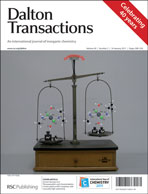Palladium complexes containing 2,7-bis(mesitylimidazolylidenyl)naphthyridine (NHC-NP) have been synthesized and characterized. Reaction of [{Ag3(NHC-NP)2}(PF6)3] with [Pd(PhCN)2Cl2] provided an unusual dipalladium complex bridged by two NHC-NP units, forming a 20-membered dinuclear metallacycle [{Pd2(NHC-NP)2Cl2}(PF6)] (2) in high yield. Treatment of 2 with KI in acetone yielded a neutral species [Pd2(NHC-NP)I4] (3). Meanwhile, the pyridinylN-heterocyclic carbene (NHC-Py) precursor, 1-(2-pyridinyl)-3-mesitylimidazolium chloride, reacted with Pd2(dba)3 directly to form the mononuclear palladium complex [Pd(NHC-Py)Cl2] (4). These complexes were characterized by elemental analyses as well as NMR spectroscopy, and the structures of 3 and 4 were further identified by X-ray diffraction analysis. The use of these palladium complexes for Suzuki–Miyaura and Kumada–Corriu coupling reactions has been examined. There is no significant difference in catalytic activities between 2 and 4 in Suzuki–Miyaura coupling reactions. However, the catalytic activity of 2 in the Kumada–Corriu coupling of ArBr with cyclohexylmagnesium bromide is quite different from that of 4. Thus complex 2 is active for the cross coupling, but complex 4 is active for the reduction of aryl halides.

You have access to this article
 Please wait while we load your content...
Something went wrong. Try again?
Please wait while we load your content...
Something went wrong. Try again?


 Please wait while we load your content...
Please wait while we load your content...